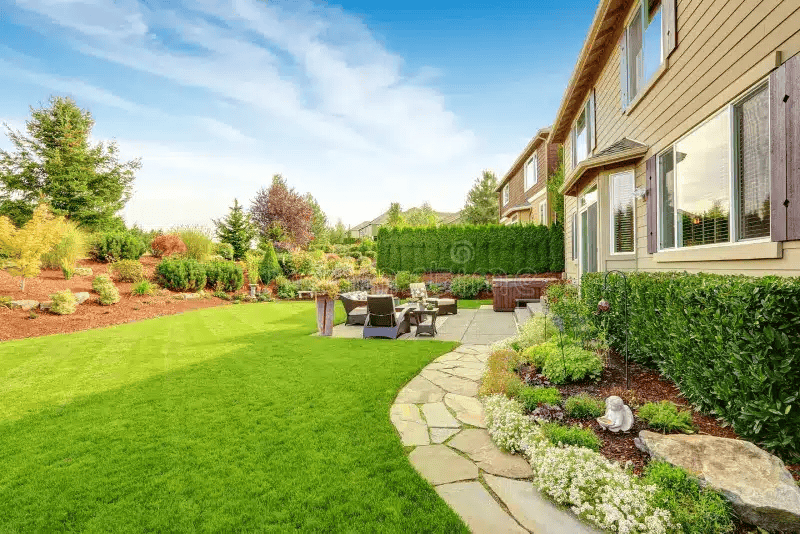Sustainability has become a crucial consideration in almost every aspect of modern life, and home landscaping is no exception. Homeowners and designers alike are increasingly recognizing the importance of incorporating eco-friendly elements into their landscaping plans. Sustainable home landscaping designs not only enhance the beauty and functionality of outdoor spaces but also contribute positively to the environment. This article explores the role of sustainability in landscaping, offering insights into eco-friendly practices that can transform any backyard into a greener, more sustainable haven.
Rise of Sustainable Landscaping
Sustainable home landscaping designs have gained popularity in recent years as more people become conscious of their ecological footprint. With the growing awareness of climate change and environmental degradation, homeowners are seeking ways to reduce water usage, lower energy consumption, and create natural habitats for local wildlife. Sustainable landscaping practices aim to conserve resources, reduce pollution, and increase biodiversity, all while enhancing the aesthetic appeal of residential spaces.
One of the primary elements of sustainable landscaping is the use of native plants. Native species are well-suited to the local climate and soil conditions, making them easier to maintain and more resistant to pests and diseases. By choosing native plants, homeowners can reduce the need for chemical fertilizers, pesticides, and excessive irrigation, which in turn reduces the environmental impact of their landscaping efforts.
Water Conservation through Sustainable Practices
Water conservation is one of the most pressing concerns in home landscaping today. Traditional landscaping often requires a significant amount of water, particularly in regions with hot, dry climates. Sustainable home landscaping designs, however, focus on minimizing water use while maintaining a healthy and vibrant garden.
One effective way to conserve water is by implementing xeriscaping. Xeriscaping is a landscaping method that uses drought-tolerant plants and efficient irrigation systems. By selecting plants that require less water, homeowners can reduce their reliance on irrigation systems and minimize water wastage. Additionally, rainwater harvesting systems can be incorporated into the design, allowing homeowners to collect and store rainwater for use in their gardens.
Smart irrigation systems, which adjust water usage based on weather conditions, are another excellent option for sustainable landscaping. These systems can be programmed to deliver the right amount of water at the right time, ensuring that plants are properly hydrated without overwatering.
Importance of Soil Health in Sustainable Landscaping
Soil health plays a crucial role in the success of sustainable home landscaping designs. Healthy soil supports the growth of plants and contributes to the overall biodiversity of the landscape. Sustainable landscaping practices aim to improve soil quality through organic methods such as composting, mulching, and crop rotation.
Composting is an effective way to recycle organic waste and enrich the soil. By adding compost to the soil, homeowners can improve its structure, increase nutrient levels, and enhance water retention. Mulching, on the other hand, helps retain moisture, suppresses weeds, and regulates soil temperature, creating a healthier environment for plants to thrive.
In addition to composting and mulching, homeowners can reduce soil erosion by planting ground covers and using erosion-control methods like terracing and retaining walls. These techniques help maintain the integrity of the soil, prevent runoff, and improve the overall stability of the landscape.
Incorporating Sustainable Materials into Your Design
Sustainable materials are a key component of eco-friendly home landscaping designs. When choosing materials for hardscaping elements such as pathways, patios, and retaining walls, it’s important to consider their environmental impact. Sustainable materials like recycled concrete, permeable pavers, and reclaimed wood not only look beautiful but also reduce the carbon footprint of the project.
Permeable pavers, for example, allow water to pass through, reducing runoff and promoting groundwater recharge. Recycled concrete can be used for walkways or patios, offering a durable, eco-friendly alternative to traditional concrete. Similarly, reclaimed wood from old structures can be repurposed for fences, decks, and other landscaping features, reducing the need for new timber and minimizing waste.
In addition to using sustainable materials, homeowners can create functional outdoor spaces by integrating natural elements such as rocks, boulders, and trees into their landscape designs. These elements provide structure, texture, and visual interest while maintaining an eco-friendly approach.
Sustainable Landscaping and Energy Efficiency
Sustainable home landscaping designs also contribute to energy efficiency by reducing the need for artificial heating and cooling. Thoughtfully placed trees, shrubs, and other plants can help regulate the temperature around the home, providing natural shade in the summer and blocking cold winds in the winter. This reduces the need for air conditioning and heating, lowering energy consumption and utility bills.
Deciduous trees, in particular, are excellent for providing summer shade. Their leafy canopies block sunlight, keeping the house cooler in hot weather. In the winter, when the trees lose their leaves, the bare branches allow sunlight to warm the home, reducing heating costs.
Moreover, incorporating green roofs and walls into your landscaping design can further improve energy efficiency. These features act as natural insulators, helping to regulate indoor temperatures and reduce the need for air conditioning or heating.
Creating Habitats for Wildlife
A sustainable home landscaping design goes beyond aesthetics—it also plays a vital role in supporting local wildlife. By incorporating a variety of plants, trees, and shrubs, homeowners can create habitats for birds, insects, and other wildlife. Native plants are particularly beneficial in this regard, as they provide food and shelter for local species that are adapted to the area’s climate.
Butterfly gardens, birdhouses, and bee-friendly plants are just a few ways to attract and support pollinators and other wildlife. Sustainable landscaping encourages biodiversity by offering spaces for creatures to thrive, contributing to the overall health of the ecosystem.
Reiki Healing for Mindful Landscaping
Creating a sustainable home landscaping design is not just about the physical environment but also about cultivating a peaceful and mindful space. Landscaping can be a form of healing, providing a space for relaxation, reflection, and connection with nature. As you plan your landscaping, consider how the space can promote emotional and spiritual well-being. Incorporating elements like water features, meditation gardens, and quiet corners for contemplation can enhance the sense of tranquility in your outdoor space.
Reiki healing, which focuses on restoring balance and energy flow, can also be a part of this mindful approach. By integrating elements that support both physical and mental well-being, such as plants known for their calming effects or spaces designed for meditation, homeowners can create a sanctuary that nourishes the mind, body, and spirit. Whether you’re seeking a retreat to relax after a long day or a space to meditate and rejuvenate, sustainable landscaping offers a way to connect with the earth while enhancing your overall well-being.
Working with Professionals
When planning a sustainable landscaping project, it’s often beneficial to work with professionals who specialize in eco-friendly designs. Landscape architects and designers can help bring your vision to life while ensuring that the principles of sustainability are integrated into every aspect of the design. Additionally, experts such as kitchen and bath remodeling contractors in LA can help incorporate sustainable elements into other parts of your home, ensuring that your entire property is in harmony with nature.
Conclusion
Sustainability in home landscaping designs is not just a passing trend—it’s a vital practice that benefits both homeowners and the environment. By focusing on water conservation, soil health, energy efficiency, and the use of sustainable materials, homeowners can create beautiful, functional, and eco-friendly outdoor spaces. Whether you’re planting native species, designing a meditation garden, or incorporating features that support local wildlife, sustainable landscaping offers endless possibilities for enhancing your home and connecting with nature. Embrace sustainability today, and transform your outdoor space into a green, tranquil haven that benefits both you and the planet.




